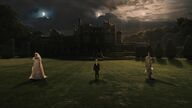Although Lars von Trier did not always follow every rule of the Dogma 95 manifesto, in The Melancholia the hand-held camera prescribed by Dogma 95 remains A prominent visual symbol identifies Trier's personal style. Trier himself recognizes the role of the handheld camera in the film: "Once you use a handheld camera, the exploration of the subject becomes part of the story. I try to be very accurate, but at the same time I hope It's kind of rambling. So when I hear someone say something, I'll pan the camera and shoot the reaction, or not, so it becomes part of the story shot with the handheld camera.
" In Lear's lens language, the use of hand-held cameras subverts Metz's "voyeurism-nudism"-style image identification mechanism to a certain extent. The movement of the hand-held camera lens contains a lot of push-pulls, pull-ups, and mechanical shakes (a feature of Dogtown, Antichrist, etc., in addition to "The Melancholy"), which makes the lens difficult to disguise The perspective of a character exposes the existence of the image medium. On the other hand, it weakens the sense of distance necessary for voyeuristic image identification (peeping is replaced by onlookers and presence), making it difficult for the audience to identify with the characters in the film.
But specifically in Melancholia, the rejection of image identification is not consistent. The most prominent example is in the first chapter, "Justin," where the wedding scene is divided into three spaces: downstairs (where Justin's husband, boss, and other guests are located), and upstairs (where Justin's mother and Justin are alone). ) and outdoors ("The Melancholy Star" and Justin's Alone Space). In the downstairs space, we can hardly see Justin's point of view shots. As a bystander, the camera constantly seeks, tracks and aggressively oppresses the moving Justin, while upstairs and outdoors, Justin's point of view shots increase significantly, The footage also becomes more steady with Justin as the subject of the shot, gazing (and sometimes peeping) at the stationary Justin. In the latter, the character identification relationship brought about by the traditional lens language is temporarily partially restored.
The different lens languages both suggest the differences between the two spaces of nature (and Justin's heterogeneity in the collective space), but also constitute the narrative dynamics of the first chapter. The imbalance of image identification constitutes the driving force for Justin to constantly escape from the collective space, and the chasing gaze pulls Justin back from the solitary space again and again, until Justin completely destroys the entire wedding.
The hysterical subject
As mentioned in the previous section, Justin has almost no viewpoint shots in the collective space, and in most of the shots that take place in the downstairs scene, she is the bearer of the aggressive gaze chasing away. And it’s worth noting that Trier provided a character basis for these tracking shots: Jack arranged to follow Justin behind Tim, the young man who pressed him about the ad words. As Justin walks anxiously through the wedding scene, the gaze that tracks her has in fact become the embodiment of the Big Other. Employment relations, social etiquette, moral imperatives (if Justin doesn't provide the ad, Tim will lose his job) all call out to Justin with stares, asking her for the ad.
In "The Sublime Object of Ideology", Zizek once analyzed Hitchcock's film "North by Northwest", thinking that the Russian agent's question ("What on earth do you want?") is a typical big The inquiring of the other, because the Russian agents hope that Sancil will occupy the desire of the big other (agent) as his own desire (that is, admit that he is the agent Kaplan), so as to realize the identification with the big other. In Melancholia, we easily find a similar discourse in the question Michael, John, and Claire ask of Justin, which is another form of Tim's gaze: "Isn't that what you want? ?Why are you not happy?"
In Zizek's view, the interrogation in "North by Northwest" did not succeed, because Sancier was not Kaplan, and could not fill his own desires with the desires of the big Other, thereby establishing identity. And when the subject cannot respond to the call of the Other, he becomes a hysterical subject. That's exactly the dilemma that a weary Justin faces at the wedding scene: she returns to the wedding scene over and over, obeys the will of the Other, pretends to be happy, even makes love to Tim while he is constantly being followed, but still Can't get rid of the constant pursuit and escape of the big Other. Justin finally gave up trying to fill the desire for the big Other when he was pressed for the slogan by his boss Jack for the last time. "You're always insatiable, Jack," she tells her boss. Realizing that she'll never be able to fill the void in the Other, Justin becomes a hysterical subject—the same hysteria that the film refers to as melancholia ( symptom).
Antigone's shadow
Lacan once examined "hysteria" from the perspective of etymology, thinking that it came from the Greek "womb", and hysteria was also referred to as a female-specific emotional disorder in Lacan's philosophy. Žižek also often uses female figures such as Antigone and Medea to illustrate the radical political potential possessed by hysterics. In Lacan-Zizek's theoretical system, hysteria is fundamentally because the object a, which is the remnant of the real, cannot find its place in the symbolic order, and the death drive contained in the real is to break the existing symbols. The power of order.
From this point of view, the gender binary construction of the hysterical/symbolic order that Trier is accustomed to in the film can seem extraordinarily meaningful. From "Medea" to "The Antichrist" to "Melancholia," women have been the bearers of radical action in Trier's films. Specifically in "Melancholia", Justin, who entered a state of hysteria (depression), violently collided with and disobeyed the three men around him: the husband who symbolized patriarchy, Jack who symbolized capital, and John who symbolized rationality. And it was that expensive wedding that connected the three. Here, capitalist society becomes the only identifiable system of signifier signs, calling upon Justin as the Big Other.
It's also why Justin's rejection of the boss, Jack, became the point of a total failure of the wedding, in a sense, the end happened early in the moment Justin turned away from Jack, even from the last time Justin answered Jack about the advert Happened when she was pressed by the other, because she discovered the utter void of the Other (the last ad she wrote for Jack was "at nothing"). In retaliation, Justin endured the exile of the Big Other, losing both her husband and her boss the moment she rejected Jack.
So we can find in Justin (especially in the chapter "Claire") the shadow of Zizek's interpretation of Antigone. When the externalized object a - Melancholy Star is about to hit the earth and completely destroy the symbolic order, the astronomer John who weaves the signifier network completely collapses and even commits suicide, and Claire (Ismene), who keeps the signifier network, desperately avoids and cry, while Justin can accept the end in peace. This is what Žižek said of Antigone: "In her obsession with the 'death drive,' in her existential, horrific, ruthless stubbornness toward death, she was freed from everyday feelings and thoughts. , passion, and fear.”
Justin’s radical potential lies not only in his death drive to dismantle the signifier network, but in his courage to imagine the real, however terrifying it may be. When little boy Leo said, "I'm afraid that star will eventually hit us anyway, and Dad said if that's the case, there's nowhere for us to run," Justin replied, "He must have forgotten something when he said that." The deep response is exactly what Jack said to Justin after Justin decided to resign, "I tell you, you can't find a job if you want" - for him, the end of reality is unimaginable, but for Justin. Words are not so. Justin didn't dig a hole at the end of the credits, as she said before, but built a wooden house on the hillside. This gesture is less about defending against doomsday, but about embracing the coming of the real beyond reality. In this sense, Melancholia is certainly a movie about the end, but the end doesn't necessarily mean the end.
View more about Melancholia reviews











